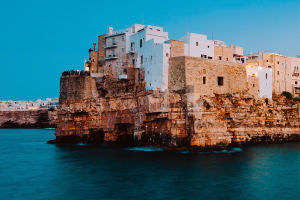Wadi Rum, also known as the "Valley of the Moon," is among the most stunning natural wonders of the Middle East. This vast, otherworldly desert, with its towering rock formations and endless sand dunes, has captivated explorers and travelers for centuries.
Wadi Rum is a living testament to the people who once inhabited it. Ancient rock carvings and Thamudic inscriptions are scattered throughout the landscape, preserving the rich history of the region.
Visitors can also find remnants of a Nabatean temple, providing insight into the architectural and cultural legacy of past societies.
What to Do in Wadi Rum?
Wadi Rum offers an array of exciting activities, ensuring an unforgettable visit:
- Trekking and Climbing: Hike through breathtaking sandstone canyons or challenge yourself with rock climbing.
- Traditional Bedouin Cooking Experience: Learn how meals are prepared underground, creating a distinct and flavorful dining experience.
- Tasting Local Dishes: Enjoy traditional dishes infused with aromatic spices, accompanied by sweet herbal tea.
- Music and Dance: Immerse yourself in the rhythms of local melodies and traditional dances, or simply take in the serenity of the surroundings.
- Stargazing: Witness a spectacular night sky, especially when staying in a transparent bubble tent.
A Jeep tour is one of the best ways to explore Wadi Rum, allowing visitors to reach remote locations and admire the desert’s breathtaking landscapes. These guided tours offer a chance to experience the true essence of this vast expanse. Travelers without the Jordan Pass must pay an entrance fee of 5 JD. The Visitor Center is the primary point of entry, where tickets and tour bookings are available. Guided excursions provide access to the most remarkable sights, ensuring a deeper appreciation of this natural wonder.
What to See in Wadi Rum?
Exploration in Wadi Rum often includes stops at:
- Mushroom Rock: A naturally sculpted rock formation, perfect for photographs.
- Wadi Um Ishrin Sand Dunes: Towering dunes reaching up to 25 meters, offering a challenging yet rewarding climb.
- Jabel Khazali and Al Mahana Canyons: Narrow passageways with ancient carvings that tell stories of those who once traveled through the desert.
One of the most unique accommodations in Wadi Rum is the bubble tent, providing a panoramic view of the desert while maintaining modern comforts. These stays offer a once-in-a-lifetime opportunity to enjoy the landscape under a starlit sky. Wadi Rum was designated a UNESCO World Heritage Site in 2011, highlighting its cultural and natural significance. The striking rock formations, deep gorges, and vast red sands create a mesmerizing environment, preserved through sustainable tourism efforts.
Navigating Wadi Rum requires the expertise of a knowledgeable guide. These professionals ensure a safe and enriching journey, sharing insights about the region’s history and natural formations. Travelers can opt for day tours or more immersive multi-day excursions, staying overnight in traditional camps to fully embrace the desert experience.
Unlike many deserts dominated by sand dunes, Wadi Rum is characterized by vast stretches of red earth and towering rock formations. These dramatic landscapes have been shaped by centuries of wind and erosion, resulting in an environment that feels almost otherworldly.
Tourism in Wadi Rum began in 1984, when a group of climbers led by Tony Howard and Di Taylor recognized its potential for adventure tourism. Today, the region attracts visitors from around the world. Thanks to ASEZA (Aqaba Special Economic Zone Authority), tourism remains environmentally responsible, preserving the desert’s beauty for future generations.
Wadi Rum is linked to Lawrence of Arabia, the famed British intelligence officer who spent time here from 1916 to 1918. Points of interest include the location believed to be his former home and Shelaali Spring, an oasis he referenced in his writings. This tranquil spot offers visitors a moment to cool off and admire the surrounding greenery.
Accomodation
For those looking to stay overnight, various options provide different levels of comfort:
- Quite Bedouine Village Camp
- Bedouin Village Camp
- Wadi Rum Desert Base Camp
- Wadi Rum Bubble Luxotel
- Memories Aicha Luxury Camp
- Wadi Rum UFO Luxotel
- Bubble 5*
Places Nearby Worth a Visit
Wadi Rum to Aqaba
- JETT Bus: Departs at 17:00 (12 JD)
- Taxi: Approx. 40 JD
- Travel time: 2 hours
Wadi Rum to Petra
- Public Bus: Departs at 8:30 (7 JD)
- Taxi: Approx. 40 JD
- Travel time: 2 hours
Wadi Rum to the Dead Sea
- Budget Option: Take the JETT Bus to Aqaba (12 JD), stay overnight, then continue the journey the next day.
- Taxi: Approx. 110 JD
- Travel time: 6 hours
From towering rock formations and rich cultural heritage to the dazzling night sky, Wadi Rum stands as one of the most remarkable places to explore in Jordan.


